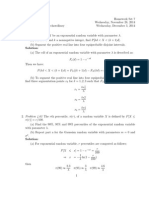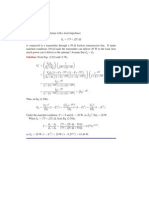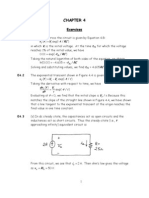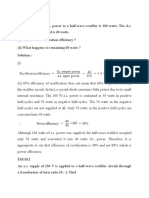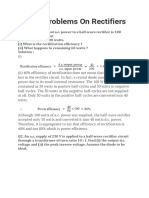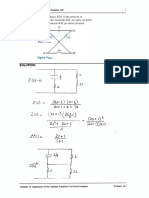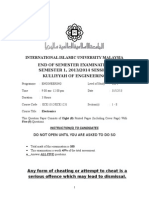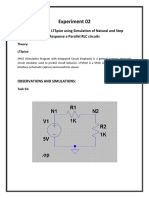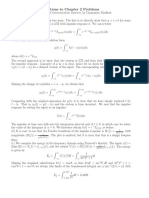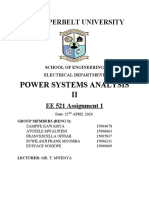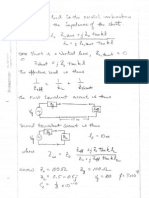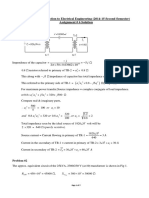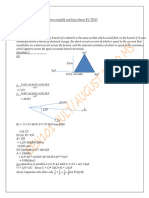Chapter 05
Chapter 05
Uploaded by
Johnny Lee Worthy IIIOriginal Description:
Copyright
Available Formats
Share this document
Did you find this document useful?
Is this content inappropriate?
Report this DocumentCopyright:
Available Formats
Chapter 05
Chapter 05
Uploaded by
Johnny Lee Worthy IIICopyright:
Available Formats
1
CHAPTER 5
Exercises
E5.1 (a) We are given ) 30 200 cos( 150 ) (
o
= t t v . The angular frequency is
the coefficient of t so we have radian/s 200 = . Then
Hz 100 2 / = = f ms 10 / 1 = = f T
V 1 . 106 2 / 150 2 / = = =
m rms
V V
Furthermore, v(t) attains a positive peak when the argument of the
cosine function is zero. Thus keeping in mind that t has units of
radians, the positive peak occurs when
ms 8333 . 0
180
30
max max
= = t t
(b) W 225 /
2
= = R V P
rms avg
(c) A plot of v(t) is shown in Figure 5.4 in the book.
E5.2 We use the trigonometric identity ). 90 cos( ) sin(
o
= z z Thus
) 30 300 cos( 100 ) 60 300 sin( 100
o o
= + t t
E5.3 radian/s 377 2 = f ms 67 . 16 / 1 = f T V 6 . 155 2 =
rms m
V V
The period corresponds to
o
360 therefore 5 ms corresponds to a phase
angle of
o o
108 360 ) 67 . 16 / 5 ( = . Thus the voltage is
) 108 377 cos( 6 . 155 ) (
o
= t t v
E5.4 (a)
o o o
45 14 . 14 10 10 90 10 0 10
1
= + = j V
) 45 cos( 14 . 14 ) sin( 10 ) cos( 10
o
= + t t t
(b) 330 . 4 5 . 2 5 660 . 8 60 5 30 10
1
j j + + + =
o o
I
o
44 . 3 18 . 11 670 . 0 16 . 11 + j
) 44 . 3 cos( 18 . 11 ) 30 sin( 5 ) 30 cos( 10
o o o
+ = + + + t t t
(c) 99 . 12 5 . 7 0 20 60 15 0 20
2
j j + + + =
o o
I
o
28 . 25 41 . 30 99 . 12 5 . 27 j
) 28 . 25 cos( 41 . 30 ) 60 cos( 15 ) 90 sin( 20
o o o
= + + t t t
2
E5.5 The phasors are
o o o
45 10 and 30 10 30 10
3 2 1
= + = = V V V
v
1
lags v
2
by
o
60 (or we could say v
2
leads v
1
by ) 60
o
v
1
leads v
3
by
o
15 (or we could say v
3
lags v
1
by ) 15
o
v
2
leads v
3
by
o
75 (or we could say v
3
lags v
2
by ) 75
o
E5.6 (a)
o
90 50 50 = = = j L j Z
L
o
0 100 =
L
V
o
90 2 50 / 100 / = = = j Z
L L L
V I
(b) The phasor diagram is shown in Figure 5.11a in the book.
E5.7 (a)
o
90 50 50 / 1 = = = j C j Z
C
o
0 100 =
C
V
o
90 2 ) 50 /( 100 / = = = j Z
C C C
V I
(b) The phasor diagram is shown in Figure 5.11b in the book.
E5.8 (a)
o
0 50 50 = = = R Z
R
o
0 100 =
R
V
o
0 2 ) 50 /( 100 / = = = R
R R
V I
(b) The phasor diagram is shown in Figure 5.11c in the book.
E5.9 (a) The transformed network is:
mA 135 28 . 28
250 250
90 10
o
o
=
+
= =
j Z
s
V
I
3
mA ) 135 500 cos( 28 . 28 ) (
o
= t t i
o
135 07 . 7 = = I V R
R
o
45 07 . 7 = = I V L j
L
(b) The phasor diagram is shown in Figure 5.17b in the book.
(c) i(t) lags v
s
(t) by . 45
o
E5.10 The transformed network is:
=
+ + +
= 31 . 56 47 . 55
) 200 /( 1 ) 50 /( 1 100 / 1
1
o
j j
Z
V 31 . 56 4 . 277
o
= = I V Z A 69 . 33 547 . 5 ) 50 /(
o
= = j
C
V I
A 31 . 146 387 . 1 ) 200 /(
o
= = j
L
V I
A 31 . 56 774 . 2 ) 100 /(
o
= = V I
R
E5.11 The transformed network is:
We write KVL equations for each of the meshes:
100 ) ( 100 100
2 1 1
= + I I I j
0 ) ( 100 100 200
1 2 2 2
= + + I I I I j j
Simplifying, we have
100 100 ) 100 100 (
2 1
= + I I j
0 ) 100 100 ( 100
2 1
= + I I j
Solving we find A. 0 1 and A 45 414 . 1
2 1
o o
= = I I Thus we have
). 1000 cos( ) ( and A ) 45 1000 cos( 414 . 1 ) (
2 1
t t i t t i = =
o
4
E5.12 (a) For a power factor of 100%, we have , 1 ) cos( = which implies that
the current and voltage are in phase and . 0 = Thus, . 0 ) tan( = = P Q
Also ( ) A. 10 )] 0 cos( 500 /[ 5000 ] cos /[ = = =
rms rms
V P I Thus we have
. 40 14 . 14 and 14 . 14 2
o
= = = I
rms m
I I
(b) For a power factor of 20% lagging, we have , 2 . 0 ) cos( = which
implies that the current lags the voltage by . 46 . 78 ) 2 . 0 ( cos
1 o
= =
Thus,
. kVAR 49 . 24 ) tan( = = P Q Also, we have ( ) A. 0 . 50 ] cos /[ = =
rms rms
V P I
Thus we have . 46 . 38 71 . 70 and A 71 . 70 2
o
= = = I
rms m
I I
(c) The current ratings would need to be five times higher for the load
of part (b) than for that of part (a). Wiring costs would be lower for the
load of part (a).
E5.13 The first load is a F 10 capacitor for which we have
= = 90 3 . 265 ) /( 1
o
C j Z
C
o
90 =
C
A 770 . 3 / = =
C rms Crms
Z V I
0 ) cos( = =
C Crms rms C
I V P kVAR 770 . 3 ) sin( = =
C Crms rms C
I V Q
The second load absorbs an apparent power of kVA 10 =
rms rms
I V with a
power factor of 80% lagging from which we have . 87 . 36 ) 8 . 0 ( cos
1
2
o
= =
Notice that we select a positive angle for
2
because the load has a
lagging power factor. Thus we have kW 0 . 8 ) cos(
2 2 2
= =
rms rms
I V P
and kVAR 6 ) sin(
2 2
= =
rms rms
I V Q .
Now for the source we have:
kW 8
2
= + = P P P
C s
kVAR 23 . 2
2
= + = Q Q Q
C s
kVA 305 . 8
2 2
= + =
s s srms rms
Q P I V A 305 . 8 / = =
rms srms rms srms
V I V I
% 33 . 96 % 100 ) /( factor power = =
srms rms s
I V P
E5.14 First, we zero the source and combine impedances in series and parallel
to determine the Thvenin impedance.
5
50 50 25 50
100 / 1 100 / 1
1
25 50 j j
j
j Z
t
+ + =
+
+ =
o
04 . 14 1 . 103 j25 100 = + =
Then we analyze the circuit to determine the open-circuit voltage.
o
45 71 . 70
100 100
100
100 =
+
= =
j
oc t
V V
o
04 . 59 6858 . 0 / = =
t t
Z V
n
I
E5.15 (a) For a complex load, maximum power is transferred for
L L t L
jX R j Z Z + = = = 25 100
*
. The Thvenin equivalent with the load
attached is:
The current is given by
o
o
45 3536 . 0
25 100 25 100
45 71 . 70
=
+ +
=
j j
I
The load power is
W 25 . 6 ) 2 / 3536 . 0 ( 100
2 2
= = =
rms L L
I R P
6
(b) For a purely resistive load, maximum power is transferred
for . 1 . 103 25 100
2 2
= + = =
t L
Z R The Thvenin equivalent with the
load attached is:
The current is given by
o
o
98 . 37 3456 . 0
25 100 1 . 103
45 71 . 70
=
+
=
j
I
The load power is
W 157 . 6 ) 2 / 3456 . 0 ( 1 . 103
2 2
= = =
rms L L
I R P
E5.16 The line-to-neutral voltage is V. 4 . 577 3 / 1000 = No phase angle was
specified in the problem statement, so we will assume that the phase of
V
an
is zero. Then we have
o o o
120 4 . 577 120 4 . 577 0 4 . 577 = = =
cn bn an
V V V
The circuit for the a phase is shown below. (We can consider a neutral
connection to exist in a balanced Y-Y connection even if one is not
physically present.)
The a-phase line current is
o
o
02 . 37 610 . 4
40 . 75 100
0 4 . 577
=
+
= =
j Z
L
an
aA
V
I
The currents for phases b and c are the same except for phase.
o o
98 . 82 610 . 4 02 . 157 610 . 4 = =
cC bB
I I
kW 188 . 3 ) 02 . 37 cos(
2
610 . 4 4 . 577
3 ) cos(
2
3 =
= =
o
L Y
I V
P
7
kVAR 404 . 2 ) 02 . 37 sin(
2
610 . 4 4 . 577
3 ) sin(
2
3 =
= =
o
L Y
I V
Q
E5.17 The a-phase line-to-neutral voltage is
o o
0 4 . 577 0 3 / 1000 = =
an
V
The phase impedance of the equivalent Y is . 67 . 16 3 / 50 3 / = = =
Z Z
Y
Thus the line current is
A 0 63 . 34
67 . 16
0 4 . 577
o
o
=
= =
Y
an
Z
V
I
aA
Similarly, A 120 63 . 34
o
=
bB
I and A. 120 63 . 34
o
=
cC
I
Finally, the power is
kW 00 . 30 ) 2 / ( 3
2
= =
y aA
R I P
E5.18 Writing KCL equations at nodes 1 and 2 we obtain
o
60 1
80 50 30 100
2 1 1
=
+
+ j j
V V V
o
30 2
80 50 50
1 2 2
=
+
j j
V V V
In matrix form, these become
(
=
(
(
(
(
(
(
|
|
.
|
\
|
|
|
.
|
\
|
+
+
30 2
60 1
80 50
1
50
1
80 50
1
80 50
1
80 50
1
30 100
1
2
1
V
V
j j j
j j j
The MATLAB commands are
Y = [(1/(100+j*30)+1/(50-j*80)) (-1/(50-j*80));...
(-1/(50-j*80)) (1/(j*50)+1/(50-j*80))];
I = [pin(1,60); pin(2,30)];
V = inv(Y)*I;
pout(V(1))
pout(V(2))
The results are
o
21 . 106 98 . 79
1
= V and
o
30 . 116 13 . 124
2
= V
8
Answers for Selected Problems
P5.4*
ms 3333 . 0 =
peak
t
P5.6* ) 72 10 2 cos( 28 . 28 ) (
4 o
= t t v V
P5.12*
P5.13* A 808 . 3 =
rms
V
P5.23* ) 09 . 82 cos( 763 . 3 ) sin( 4 ) 75 cos( 3 ) 75 cos( 5
o o o
+ = + + t t t t
P5.24*
W 1
V 071 . 7
ms 2
radians 3 60 angle phase
Hz 500
rad/s 1000
=
=
=
= = =
=
=
P
V
T
f
rms
o
V 61 . 10 =
rms
V
( ) ( )
o
45 cos 4 . 141 = t t v
s
o
o
o
45 by leads
45 by lags
90 by lags
2 s
1 s
1 2
V V
V V
V V
9
P5.25*
P5.35*
( ) ( )
o
90 by lags t v t i
L L
P5.37*
( ) ( )
o
90 by leads t v t i
C C
( ) ( )
( )
( ) ( )
( ) ( )
( ) ( )
( ) ( )
o
o
o
o
o
o
60 by leads
60 by lags
120 by lags
90 400 cos 10
) 150 400 cos( 5
30 400 cos 10
3 2
3 1
2 1
3
2
1
t v t v
t v t v
t v t v
t t v
t t v
t t v
+ =
+ =
+ =
( )
( ) ( ) ( ) ( ) ( ) t t t i
Z
L
L
L
L
= =
=
=
=
2000 sin 20 1 90 2000 cos 20 1
90 20 1
0 10
90 200
o
o
o
o
I
V
( ) ( ) ( ) t t t i
Z
Z
C
C
C
2000 sin 6283 . 0 90 2000 cos 6283 . 0
90 6283 . 0
0 10
90 92 . 15
C C
C
= + =
= =
=
=
o
o
o
o
V I
V
10
P5.42*
o
45 by lags
s
V I
P5.44*
o
43 . 63 by leads
s
V I
P5.46*
o
57 . 71 1 . 158 : 500 = = Z
o
0 50 : 1000 = = Z
o
57 . 71 1 . 158 : 2000 = = Z
P5.49*
The peak value of ( ) t i
L
is five times larger than the source current!
mA 90 50
mA 90 50
mA 0 10
o
o
o
=
=
=
C
L
R
I
I
I
V 45 071 . 7
V 45 071 . 7
mA 45 71 . 70
o
o
o
=
=
=
L
R
V
V
I
V 57 . 26 944 . 8
V 43 . 63 472 . 4
mA 43 . 63 472 . 4
o
o
o
=
=
=
C
R
V
V
I
11
P5.52*
o
56 . 26 by lags
s
I V
P5.67*
P5.69* This is a capacitive load.
kW 5 . 22 = P
kVAR 25 . 11 = Q
power factor % 44 . 89 =
apparent power 16 . 25
2 2
= + = Q P KVA
P5.78*
P5.83* (a)
(b)
The capacitor must be rated for at least 387.3 kVAR.
(c) The line current is smaller by a factor of 4 with the capacitor in
place, reducing R I
2
losses in the line by a factor of 16.
o
52 . 75 2 400 = I
F 1027 = C
o
0 100 = I
lagging % 62 . 84 factor Power
kVA 26 power Apparent
kVAR 84 . 13
kW 22
=
=
=
=
s
s
Q
P
mA 44 . 63 72 . 44
mA 56 . 26 44 . 89
V 56 . 26 944 . 8
o
o
o
=
=
=
C
R
I
I
V
leading % 57 . 93 factor Power
kVA 68 . 10 power Apparent
kVAR 770 . 3 Q
kW 10
66 . 20 11 . 15
=
=
=
=
=
P
o
I
12
P5.87* (a)
o
57 . 26 789 . 1 =
n
I
(b) W 50 =
load
P
(c) W 21 . 47 =
load
P
P5.91* = 5 . 12
load
R
F 1 . 106 =
load
C
P5.95* =
05 . 62 29 . 70
o
Z
P5.96*
P5.99*
o
0 87 . 59 =
aA
I
kW 38 . 5
kW 89 . 26
30 56 . 34
20 . 8 558
80 . 21 44 . 322
=
=
=
=
=
line
load
AB
AB
An
P
P
o
o
o
I
V
V
P5.105*
o
58 . 29 402 . 9
1
= V
o
45 . 111 986 . 4
2
= V
P5.107*
o
96 . 120 372 . 1
1
= I
o
22 . 136 955 . 1
2
= I
kW 36 . 19
rms A 67 . 14
rms V 1 . 762
=
=
=
P
I
V
L
L
13
Practice Test
T5.1 ( ) A 828 . 2 8 ) 3 (
3
1 1
2
0
3
2
0
2
0
2
= = = = =
t dt t dt t i
T
I
T
rms
W 400 ) 50 ( 8
2
= = = R I P
rms
T5.2 5000 . 2 3301 . 4 5355 . 3 5355 . 3 30 5 45 5 j j + = + = V
= = 50 . 37 9144 . 9 0355 . 6 8657 . 7 j V
) 50 . 37 cos( 914 . 9 ) ( = t t v
T5.3 (a) V 61 . 10
2
15
1
= =
rms
V
(b) 200 = f Hz
(c) 400 = radians/s
(d) 5 / 1 = = f T ms
(e) = 45 15
1
V and = 30 5
2
V
V
1
lags V
2
by 15
or V
2
leads V
1
by 15
T5.4 A 45 7071 . 0
45 14 . 14
0 10
5 15 10
0 10
/
=
=
+
=
+
=
j j C j L j R
s
V
I
V 135 303 . 5 5
V 45 606 . 10 15 V 45 071 . 7 10
= =
= = = =
I V
I V I V
j
j
C
L R
T5.5 3535 4213 40 5500 ) 10 25 )( 30 440 ( *
2
1
2
1
j + = = = = VI S VA
lagging % 6 . 76 ) 40 cos( ) cos( factor Power
VA 5500 power Apparent
VAR 3535 ) Im(
W 4213 ) Re(
= = =
= =
= =
= =
I v
Q
P
S
S
S
T5.6 We convert the delta to a wye and connect the neutral points with an
ideal conductor.
3 / 8 2 3 / j Z Z
Y
+ = =
067 . 3 3 . 2 667 . 2 2 4 . 0 3 . 0 j j j Z Z Z
Y line total
+ = + + + = + =
V
2
V
1
14
= 13 . 53 833 . 3
total
Z
A 13 . 23 26 . 54
13 . 53 833 . 3
30 208
=
= =
total
an
aA
Z
V
I
T5.7 The mesh equations are:
= + 45 10 ) ( 15 10
2 1 1
I I I j
15 ) ( 15 5
1 2 2
= + I I I j
In matrix form these become
(
=
(
+
15
45 10
) 5 15 ( 15
15 ) 10 15 (
2
1
I
I
j
j
The commands are:
Z = [(15+j*10) -15; -15 (15-j*5)]
V = [pin(10,45); -15]
I = inv(Z)*V
pout(I(1))
pout(I(2))
You might also like
- Home Assignment No-3 (CLO1) : School of Electrical Engineering and Computer ScienceDocument2 pagesHome Assignment No-3 (CLO1) : School of Electrical Engineering and Computer ScienceNida Wakeel0% (1)
- hw7 SolDocument5 pageshw7 SolDylan LerNo ratings yet
- Formula Handbook For IPhoDocument4 pagesFormula Handbook For IPhoAbhishek SahariaNo ratings yet
- Problem 2.46: SolutionDocument1 pageProblem 2.46: SolutionEric KialNo ratings yet
- Https - Myguru - Upsi.edu - My - Documents - 2019 - Courses - SFT3053 - Material - K00926 - 20190912094449 - Chapter 1 FLS PDFDocument52 pagesHttps - Myguru - Upsi.edu - My - Documents - 2019 - Courses - SFT3053 - Material - K00926 - 20190912094449 - Chapter 1 FLS PDFNurazin RizalNo ratings yet
- Probability and Stochastic Processes Quiz Solution ManualDocument83 pagesProbability and Stochastic Processes Quiz Solution Manualsugianto_thoengNo ratings yet
- SOLUTION-Introduction To Modern Power ElectronicsDocument37 pagesSOLUTION-Introduction To Modern Power Electronicsluckywanker33% (3)
- Chapter 06Document13 pagesChapter 06Johnny Lee Worthy IIINo ratings yet
- Chapter 04Document13 pagesChapter 04Johnny Lee Worthy IIINo ratings yet
- Chapter 10Document18 pagesChapter 10WiltuzNo ratings yet
- Solution Sheet 2 Electronic CircuitsDocument15 pagesSolution Sheet 2 Electronic CircuitsWajdi BELLILNo ratings yet
- Assignmnet 02 RevisedDocument3 pagesAssignmnet 02 RevisedBilal Ayub100% (1)
- Solved Problems On RectifiersDocument12 pagesSolved Problems On RectifiersAravind KarthikNo ratings yet
- Cap 14 PDFDocument182 pagesCap 14 PDFRicardo Lima100% (1)
- GATE EE 2010 With SolutionsDocument49 pagesGATE EE 2010 With SolutionsKumar GauravNo ratings yet
- Assignment 04 Power ElectronicsDocument3 pagesAssignment 04 Power ElectronicsTayyab Hussain0% (1)
- BEE4413 Chapter 7Document20 pagesBEE4413 Chapter 7NUrul Aqilah MusNo ratings yet
- Analysis Using Laplace Function 3Document33 pagesAnalysis Using Laplace Function 3hafidahnsNo ratings yet
- Circ 4Document66 pagesCirc 4musa100% (5)
- Direction Cosines and Direction Ratios: TopicsDocument23 pagesDirection Cosines and Direction Ratios: TopicsarjunsaiNo ratings yet
- Unit-7 (BJT & Its Biasing) 1llDocument86 pagesUnit-7 (BJT & Its Biasing) 1llAnurag SinghalNo ratings yet
- Conditions of BalanceDocument4 pagesConditions of BalanceKhalil Ali0% (1)
- Qdoc - Tips Solucionario Teoria de Circuitos y Dispositivos ElDocument372 pagesQdoc - Tips Solucionario Teoria de Circuitos y Dispositivos ElDiego Alejandro Becerra MartinezNo ratings yet
- Solutions Manual Microelectronic Circuits Analysis and Design 2nd Edition RashidDocument10 pagesSolutions Manual Microelectronic Circuits Analysis and Design 2nd Edition RashidOrlando Ernesto Abreu CruzNo ratings yet
- Electrical Machines: IES Electrical Engineering Topic Wise QuestionsDocument78 pagesElectrical Machines: IES Electrical Engineering Topic Wise QuestionsahmedNo ratings yet
- Chapter 11 CircuitDocument22 pagesChapter 11 CircuitAndrew PontanalNo ratings yet
- Operational Amplifier Exam QuestionDocument3 pagesOperational Amplifier Exam QuestionKuseswar Prasad100% (1)
- Chapter 1. Griffiths-Vector Analysis - 1.1 1.2Document24 pagesChapter 1. Griffiths-Vector Analysis - 1.1 1.2Hazem TawfikNo ratings yet
- Matlab and Simulink For Modeling and Control DC MotorDocument14 pagesMatlab and Simulink For Modeling and Control DC MotorGhaleb AlzubairiNo ratings yet
- Eed3001 Lab2 Single Phase Transformer Loading EM3000Document5 pagesEed3001 Lab2 Single Phase Transformer Loading EM3000Burak YılmazNo ratings yet
- Ejercicios PDFDocument4 pagesEjercicios PDFOrlando FernandezNo ratings yet
- Elements of Electromagnetics - M. N. O. SadikuDocument55 pagesElements of Electromagnetics - M. N. O. SadikuaBHINo ratings yet
- Ch12 VariableFrequencyResponseAnalysis8EdDocument105 pagesCh12 VariableFrequencyResponseAnalysis8EdThinh Nguyen TanNo ratings yet
- Analysis of Differential Amplifiers by Muhammad Irfan Yousuf (Peon of Holy Prophet (P.B.U.H) )Document133 pagesAnalysis of Differential Amplifiers by Muhammad Irfan Yousuf (Peon of Holy Prophet (P.B.U.H) )Sohail YousafNo ratings yet
- Analysis of Low Pass RC and High Pass RL Filter Circuits: ObjectiveDocument7 pagesAnalysis of Low Pass RC and High Pass RL Filter Circuits: Objectiveayesha amjad100% (1)
- Chapter 7 of Fundamentals of MicroelectronicsDocument33 pagesChapter 7 of Fundamentals of MicroelectronicsjenellaneNo ratings yet
- Final Exam ECE 1312 Question Sem-1 2013-2014Document9 pagesFinal Exam ECE 1312 Question Sem-1 2013-2014Fatihah AinaNo ratings yet
- Cap 13 PDFDocument140 pagesCap 13 PDFRicardo LimaNo ratings yet
- Network Theorms ProblemsDocument14 pagesNetwork Theorms ProblemsVinod Shanker ShringiNo ratings yet
- Experiment 02: Introduction To Ltspice Using Simulation of Natural and Step Response A Parallel RLC CircuitsDocument8 pagesExperiment 02: Introduction To Ltspice Using Simulation of Natural and Step Response A Parallel RLC CircuitsSuleman MalikNo ratings yet
- Applications of Laplace Transform Unit Step Functions and Dirac Delta FunctionsDocument8 pagesApplications of Laplace Transform Unit Step Functions and Dirac Delta FunctionsJASH MATHEWNo ratings yet
- Solns ch2Document17 pagesSolns ch2Soumitra BhowmickNo ratings yet
- Department of Electrical and Computer Engineering Course Ecse-361 Power Engineering Assignment #1 SolutionsDocument28 pagesDepartment of Electrical and Computer Engineering Course Ecse-361 Power Engineering Assignment #1 SolutionsShuvojit GhoshNo ratings yet
- EEE3405Tut1 5QSDocument10 pagesEEE3405Tut1 5QSArjunneNo ratings yet
- EE 521 Assignment 1Document10 pagesEE 521 Assignment 1Suwilanji MoombaNo ratings yet
- Lampiran Soal 1.: PenyelesaianDocument4 pagesLampiran Soal 1.: PenyelesaianFabriyana Retno AstriniNo ratings yet
- Ee366 Chap 5 2Document28 pagesEe366 Chap 5 2Michael Adu-boahenNo ratings yet
- 67652-NilssonSM Ch07Document94 pages67652-NilssonSM Ch07fermisk1212No ratings yet
- Problem 2) 2000 Cos (10) ( : T AvgDocument8 pagesProblem 2) 2000 Cos (10) ( : T AvgSova ŽalosnaNo ratings yet
- Spring 2014 HW 4 SolnsDocument24 pagesSpring 2014 HW 4 SolnsZahraa TajAlssir AbouSwarNo ratings yet
- 279 39 Solutions Instructor Manual Chapter 10 Symmetrical Components Unsymmetrical Fault AnalysesDocument28 pages279 39 Solutions Instructor Manual Chapter 10 Symmetrical Components Unsymmetrical Fault AnalysesAshutoshBhattNo ratings yet
- 67654-NilssonSM Ch09Document61 pages67654-NilssonSM Ch09Marcela GuimaraãesNo ratings yet
- Lista 5Document22 pagesLista 5vsabioniNo ratings yet
- Full-Wave Controlled Rectifier RL Load (Continuous Mode)Document6 pagesFull-Wave Controlled Rectifier RL Load (Continuous Mode)hamza abdo mohamoud100% (1)
- ESO 203A: Introduction To Electrical Engineering (2014-15 Second Semester) Assignment # 6 SolutionDocument7 pagesESO 203A: Introduction To Electrical Engineering (2014-15 Second Semester) Assignment # 6 SolutionTejasv RajputNo ratings yet
- Examples ExamplesDocument14 pagesExamples ExamplesWang SolNo ratings yet
- Engineering Academy: MOCK GATE (2012) - 2Document12 pagesEngineering Academy: MOCK GATE (2012) - 2shrish9999No ratings yet
- EE Main Alternating Current Previous Year Questions With Solutions PDFDocument7 pagesEE Main Alternating Current Previous Year Questions With Solutions PDFSandip JadhavarNo ratings yet
- Assignment All+Sem+II+20132014Document115 pagesAssignment All+Sem+II+20132014Azlin HazwaniNo ratings yet
- 2020 July Eeng101Document7 pages2020 July Eeng101senawayne191No ratings yet

